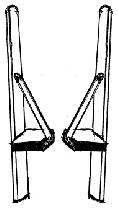
Stilts
by Norris Chambers

You don't hear much about stilts any more. Actually, they were a staple tool in the play box of country kids in the days of the Old Timer. We didn't call them stilts, although we had heard the name. We called them Tommy Walkers. I don't know why we used this name. That is what the old timers in those days called them.
Of course all stilts were home made. It wasn't something you went to the store and bought. They came in as many designs as there were builders, but most of them followed this pattern. First you found two straight, strong boards about two or three inches wide and an inch in diameter. Next, you sawed a block off of a two by four from three to five inches in length, depending on the width of your foot. You then nailed the block flat side up on one of the boards, being careful to place it at the height you wanted you legs to be. This was usually from about eight inches to a foot or so, depending on the walker's confidence and skill. A leather strap was nailed to the end of the block and also to the long board about six or eight inches above the step. This served as a brace to support your weight and also a barrier to keep your foot from slipping off the end of the step. If no leather was available, you could use baling wire.
A cruder type of stilts was sometimes made from a willow branch. The raw material had to be a reasonably straight limb about an inch and a half to two inches in diameter with a strong limb protruding. This limb was cut to the desired length (depending on how tall the boy was) with the protruding limb at the spot where the step, or stirrup, was to be. The step was cut to three or four inches from the main limb and the leather strap applied as a brace. This was a crude looking stilt, but it work as well as the nicer looking ones. You had to make two, one for each side, as near alike as possible.
In later years Clifton and I made stilts out of half-inch pipe, welding the steps and braces. These were pretty heavy, but they served a purpose. We were able to weld foot-shaped pieces of sheet metal on the bottoms, making it possible to stand still.
In stilt walking, it wasn't practical to stand still. You had to keep moving or jogging in order to maintain your balance.
Stilts sometimes served a useful purpose. In the summer when every farm boy shed his shoes, he could get on his stilts and walk across patches of grass burrs or heel pullers with ease. If the ground was hot enough to hurt, as it sometimes was, he could travel on his tommy walkers. If he needed a little more height to look in a bird's nest or pick a ripe peach, the tommies provided it. He could also wade across a small creek without getting his feet wet. Also, if a belligerent cow or goat attacked, the stilt made a nice weapon. It also served as a snake killer if it was needed for that purpose.
We had many different stilts. There were racing stilts, wading stilts, fancy stilts and just plain utility stilts. Sometimes we built them with legs four or five feet off of the ground. We never strapped the stilts to our legs like the clowns in the circus do. The upper shafts came almost to our armpits when we were walking and we held on to the handles tightly. It was also easy to pull your feet out and jump if you lost your balance.
Many commercial stilts are available now. They are used by builders who need extra height for plastering, etc., and by entertainers who wear them under their pants and look very tall. But I doubt very seriously if the kids today make Tommy Walkers just for fun and play with them like we did.
Modern lads are missing many home built toys that were great fun. But on the other hand, they are playing with a lot of toys now that we never dreamed of.
But I still think it was a lot of fun to play basketball or baseball on stilts. It added a new dimension to the game!
Actually, kids play to have FUN, and where there are kids there will be toys, whether bought or built and either variety will provide a lot of FUN!